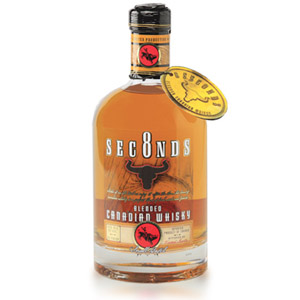Initially, I had a hard time understanding Barrell. They’re an independent bottler and blender in the same vein as the score of scotch independents that put out large amounts of mostly single barrel whiskies, except Barrell does this for American bourbons and ryes and is mostly known for their blends. That sounds great, but every Barrell release I’ve seen starts at like $80. Eighty bucks for bourbon? Even good cask strength bourbon can be readily found for $30 and under. I didn’t get what value Barrell added that was worth more than double. I ended my Barrell bourbon review with a pithy backhanded comment about expensive bourbon that doesn’t need to be expensive and left it at that.
Then I heard about Seagrass.
We should pause here to note something that longtime readers already know about me: I’m a sucker for a good finish. My favorite whisky of all time was a calvados finish (why aren’t there more of these?!). Most of my favorite single malts are finishes, from sherry to Sauternes. Port-finished GlenDronach? Sign me up!
So back to Seagrass. Imagine if you will several parcels of rye whiskey sourced from all over the place (to wit, Kentucky, Indiana, Tennessee, and Canada) and finished separately in Martinique rhum agricole casks, Madeira wine casks, and APRICOT BRANDY BARRELS. What is this madness? I would happily slap down 90 bills for anything finished in an apricot brandy barrel, alone. I had no choice; I had to buy my second-ever bottle of Barrell and give it another go, for the sake of the apricot brandy.
So we have the aforementioned rye parcels aged in the aforementioned barrels and bottled at a cask strength of 59.2% ABV. Information on where these whiskies came from is scarce, and my usual online sleuthing turned up only conjecture. That conjecture, if you’re curious, is that based on Barrell’s usual sources the Indiana component is maybe 7 year-old MGP rye while the Canadian component could be 13 year-old rye from Alberta Distillers. The Tennessee rye is probably Dickel (Barrell has sourced from Dickel before), although Dickel’s rye is technically also made at MGP. The Kentucky component is anybody’s guess. Several commentators proposed that the base (unfinished) set of ryes is the same as Barrell Rye Batch #003, but 003 had Polish rye, so I think this one is similar but not the same. My bottle is #1579 for whatever that’s worth.
Note that while the company has some excellent details on their website about each batch of their core range, the Seagrass page is sparse on specifics.
Nose: Holy fruit notes, Batman! Unctuous sprays of lychee, pineapple, kiwi, apricot both fresh and dried – oh God the apricot – sugarcane, green banana, red currant, and tart cherry. All of this arrayed on a canvas of robust oaky rye whiskey. The usual rye elements (spices, herbs) are subsumed by all the fruit, but can be detected lurking in the background. A rest in the glass only serves to deepen the fruit notes and concentrate them. Definitely let it sit after your first taste.
Palate: Gooey syrupy body. Dripping with jam, molasses, and … I don’t even know… liquid gummy bears? And then all of that is set on absolute FIRE. I can’t feel my tongue for a solid 15 seconds. After, all of the fruits remain and are joined by dried and jammed versions of each. Fruit compote, port wine reduction, it’s all there.
Finish: Medium-long. Now some slightly bitter barrel char arrives and the fruit notes take a backseat. Cocoa nibs, leaf tobacco, and mouth-drying oaky tannin. Fades slowly but without evolving.
With Water: A few drops of water initially mute some of the tart fruits, leaving the dried/jammed ones. The water also brings out a little vanilla and just so slightly tames the palate burn. With this one I’m just as happy with water as without.
Overall: Wow. Just… wow. I can honestly say I have never tasted a single whiskey (or whisky) with so many different flavors in one mouthful. This is Willy Wonka’s Three Course Dinner Chewing Gum in convenient liquid form. It’s the happiest I’ve ever been to spend $85 on a North American whiskey, and I don’t think it’s hyperbole to say that it may now be my second-favorite rye of all time. (After Winkle Family Reserve 13 year.)
After writing this review, I went and bought a second bottle. Why is this not sold out everywhere? The answer, according to an industry contact, is that bottles sell out based on their names not based on the quality of the liquid. There’s a lesson in there.








Welp, looks like I’m gonna have to go grab myself a couple of bottles of this. Luckily one of my locals has it for $76, which is decent.
I always suggest buying one bottle first. Just because I loved it doesn’t mean you will. 🙂
Thanks for this. Would love to see your thoughts on Armida as well. I was able to get a pour of Dovetail at a bar, and it wasn’t my favorite. Angel’s Envy Rye is one of my favorites so I’m looking forward to this one.
I keep circling around this one wondering whether to buy it or not. I love the idea of the finishes, the complexity, the rye, the notion of trying to capture coastal flavors, etc. And I was excited by your review and your great point that people are missing this because they are targeting scarcity over flavor.
My hesitation is due to a previous taste I had of Barrell Dovetail, which I found off-puttingly hot. I’m a regular drinker of cask strength bourbon, and generally prefer higher proof. I’ve rarely found a dram too hot, but I really did with Barrell Dovetail.
A few reviews of Seagrass have suggested that it is delicious but drinks a little hot, which worried me. And now your otherwise glowing review confirms my fears. 15 seconds of not being able to feel your tongue sounds pretty hot!
So my question is–can you provide any more details about your experience with the heat? Did the heat detract from your experience at all–did you like Seagrass in spite of the heat? Or did you find the heat a non-issue?
Thank you for any thoughts you might have and thank you for your wonderful blog!
I never mind “hot” cask strength whiskies, personally, and I end up drinking a lot of them. To me the tongue burn dissipates after several seconds and then I can enjoy the density and concentrated nature of the flavors… something that can’t be done at 46%. I’ll give this another taste this evening and try to give you a more specific answer.
Yeah I tasted it again, and there’s no getting around it. It drinks hot. I like it that way, but that doesn’t mean you will. Watering it down is always an option, but then you’re playing roulette with the volatile compounds and how steady your pouring hand is. 🙂
Nathan, thanks a lot for this great follow-up! I really appreciate it!